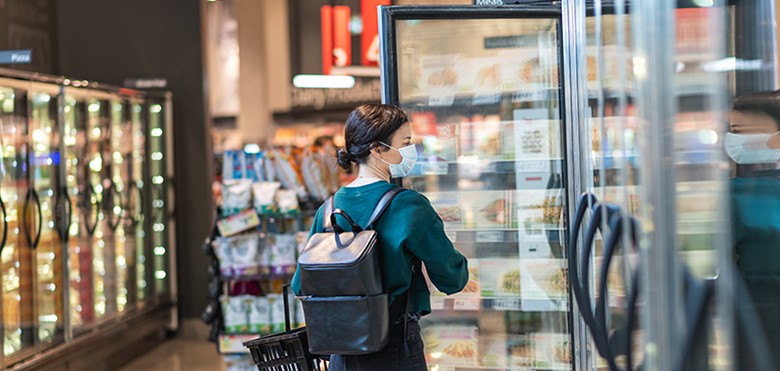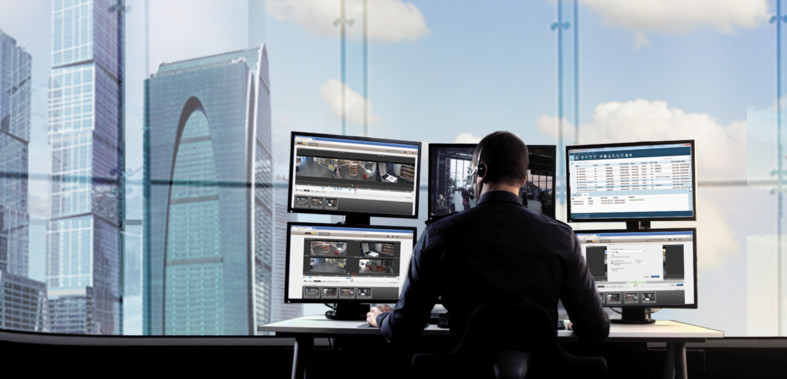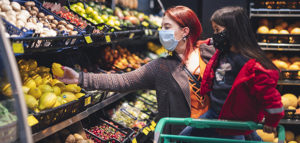The future of supermarkets is automated: IP-based security solutions enable advanced shopping
Imagine you’re about to enter a supermarket. The doors open automatically after scanning your individual QR code, a pre-recorded voice message welcomes you to the store, background-music starts playing, and a voice informs you about the latest offers – tailored to your interests.
This scenario of a digitalized store is no longer a far-off dream anymore. Particularly since the start of the corona pandemic, digitalization in the retail sector has gained significant momentum and consumer acceptance of autonomous shops is also increasing.
Changed consumer behavior requires adaption
The reason for this change of mind is partly because the pandemic-related rules, measures and restrictions have radically changed the way we shop. To effectively protect themselves against infection, consumers want a shopping experience that is as simple, quick and, above all, as contactless as possible. A m1nd-set study from June 2020, for example, showed that 62 per cent of customers no longer want to go near sales staff.
Ideally, today’s supermarkets should not only offer distance shopping, but also have systems in place that avoid queues, allow payment by card or smartphone and offer longer opening hours. In order for brick-and-mortar retail to hold its own against e-commerce, it must respond to the new needs of consumers. Technology and automation can hereby help to make supermarket shopping a more pleasant and safer experience for consumers.
No people, no problem? – The new cashierless shopping
We’ve seen supermarkets with self-service checkouts and they’re here to stay, but the trend goes further, towards cashier less supermarkets, completely without staff. Similar to the move to increased working from home, it looks as if this slow but steady shift to automated supermarkets will continue to grow even after the pandemic.
In the USA, Amazon has long since led the way with Amazon Go, where customers can shop based on the “grab-and-go” principle. No checkout is required – it is completely automated and handled via QR codes (to ‘sign-in’ and enter the shop) and cameras. This advanced shop format is slowly coming to Europe as well.
In some European markets, such as Germany, fully automated mini-supermarkets are now finding their way into city centers. One example is ‘teo’ the digital self-service shop of the supermarket chain Tegut in Fulda. Here, customers can easily gain access to the shop using an app and their smartphone, scan products directly at the shelf and pay independently using the app or at a payment terminal. And all this on a 24/7 basis.
The role of IP-based surveillance systems in automated stores
The foundation for such store concepts are IP-based security systems. Network video cameras with integrated video analytics not only help against theft and vandalism. In combination with other technologies such as access control, audio solutions and people counting systems, they enable a contactless shopping experience for the customer.
With the help of access control via a debit card reader or via an app and a QR code, the shopkeeper always knows who enters the supermarket and when. In combination with a video-based system for counting people, only registered people can enter the shop and overcrowding can be prevented by ensuring that distancing rules are being observed. A screen or a traffic light system at the entrance can provide information about the current occupancy of the shop. This is also in line with customer wishes: A recent study by Multiscope (undertaken on behalf of Axis) shows that over a third of the surveyed participants (39 per cent) would like to know how many people are in a shop before they enter it.
In the shop itself, an IP audio system can welcome customers via network speakers, play targeted advertising messages or use background music to create a pleasant shopping atmosphere. In addition, announcements can help ensure compliance with hygiene regulations and remind people, for example, to wear a mask at all times.
In the checkout zone, intelligent video analysis helps to prevent shrinkage. Software analyses goods in a customer’s shopping trolley based on the video image and ensures that the products are scanned correctly. A suitable video management software (VMS) tailored to the store size and requirements helps to connect and control the individual solutions more easily, giving the operators a better overview of the whole shop.
Sweet automation: Unmanned operations to the rescue
The case of a confectionary retailer in Sweden shows that this form of automating the shopping experience can not only benefit the retailer and make processes more efficient. It also helped the shop to stay open during the pandemic.
The shop needed to reduce costs and had a few members of its staff furloughed. In order to maintain its (now unmanned) business, while still keeping customers safe and stores secure, the storekeeper decided to radically transform and implement a digital solution.
The solution was a cloud-based system, consisting of a door control solution, network cameras and loudspeakers as well as a digital access control system, and a video management tool to control the different solutions remotely and from a centralized location.
Access is granted contactless via a QR code reader and BankID activation (a common identification system in Sweden). Once inside, a store welcome message is automatically triggered as lights switch on and ambient music begins to play. This is followed by audio instructions that explain how to use the store, and payment is completed at a digital checkout terminal, where customers weigh and scan their confectionery.
Once the customers have left the store, the system goes into energy saving mode and switches off music and lights until the next person enters. This offers a distinct advantage over manned stores which still use power even during calm periods.
This transformation to an automated store allowed the storekeeper to extend opening hours, reduce costs significantly and increase revenue as people appreciated the added flexibility thanks to 24/7 access.
The future of shopping
The automation of stores is a steady process and with advanced developments in technology the possibilities are growing – we’ve already seen how quickly the retail sector moved from stores that only require a barcode scan of the products to purchase them, to being able to just walk out, without having to physically check out anymore.
With the right video analytics, it will be possible to personalize these digitalized shopping experiences even more for customers. For example, automated voice messages can be optimized by using the video camera system to track customers’ movements around the store, guiding them to the right aisle and give special offers for products that are on display at the checkout.
The possibilities and combinations of solutions are numerous and the new form of shopping offers more flexibility, which in turn addresses different people’s lifestyles. Great customer service is entering an exciting, and automated, age.
For more information about solutions within Retail please visit our solution page.



